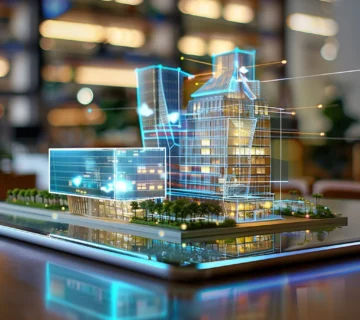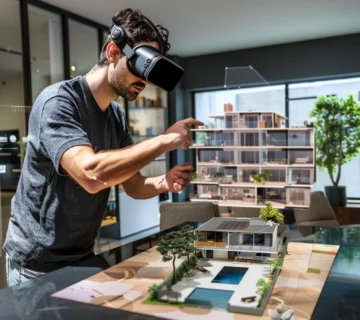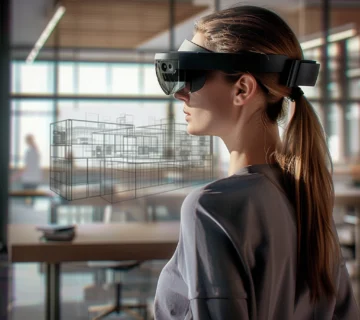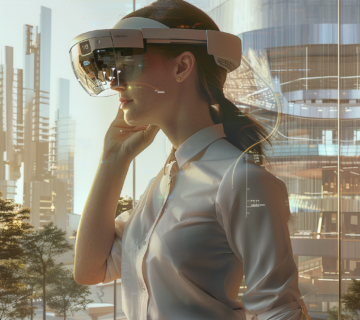The Proven Augmented Reality in Architecture: Transforming Designs into Immersive Experiences for Unmatched Impact
Introduction:
In the fast-evolving landscape of architecture, innovation is not just a choice but a necessity. It’s the cornerstone upon which progress is built, constantly driving the industry forward. Augmented Reality (AR) has emerged as a beacon of this innovation, fundamentally transforming the way architects perceive, conceptualize, and present their designs. Augmented Reality in Architecture isn’t just a buzzword; it’s a revolutionary tool reshaping the very fabric of the profession.
Traditionally, architects have grappled with the limitations of static blueprints and scale models, which often fail to fully convey the depth and complexity of their designs. Enter Augmented Reality, a game-changer that propels architecture into a new era of visualization and interaction. With AR, architects can transcend the confines of traditional mediums, breathing life into their creations and offering stakeholders an immersive journey through their vision.
Imagine standing on the site of a future skyscraper, surrounded not by mere drawings, but by a digital representation of the towering structure, seamlessly integrated with the existing environment. Augmented Reality in Architecture transforms this vision into reality, allowing architects to overlay digital renderings onto the physical world, blurring the lines between imagination and actuality. Suddenly, what was once confined to paper leaps into three-dimensional space, inviting exploration and interaction like never before.
But the impact of Augmented Reality in Architecture extends far beyond mere visualization. It serves as a catalyst for deeper understanding, offering unparalleled insight into spatial design and functionality. Architects can now manipulate virtual elements in real-time, experimenting with different configurations, materials, and lighting conditions to fine-tune every aspect of their designs. This dynamic process not only enhances creativity but also facilitates more informed decision-making, ultimately leading to better-designed spaces that resonate with their occupants.
Moreover, Augmented Reality fosters collaboration and communication in ways previously thought impossible. Architects, clients, engineers, and contractors can now converge in a virtual space, regardless of their physical location, to co-create and refine designs collaboratively. This seamless integration of diverse perspectives not only expedites the design process but also ensures that everyone involved remains aligned with the project’s objectives, thereby minimizing misunderstandings and costly revisions down the line.
In essence, Augmented Reality in Architecture represents a seismic shift in the profession, transcending the boundaries of traditional design practices and ushering in a new era of innovation and possibility. Its proven benefits are undeniable, from enhancing visualization and collaboration to streamlining the design process and ultimately delivering superior outcomes. As we delve deeper into this transformative technology, it becomes increasingly evident that Augmented Reality isn’t just reshaping architecture—it’s revolutionizing it, one immersive experience at a time.
Top of Form
Bridging the Imagination Gap
Traditionally, architects have navigated the complex terrain of design communication using two-dimensional drawings and physical scale models. While these methods served as valuable tools, they often fell short in capturing the true essence and spatial dynamics of a proposed structure. However, the advent of Augmented Reality in Architecture has heralded a paradigm shift, effectively bridging the imagination gap that once hindered effective design visualization.
Augmented Reality in Architecture transcends the limitations of traditional mediums by seamlessly integrating digital renderings into the physical environment. By superimposing intricate architectural details onto real-world spaces, AR empowers stakeholders to immerse themselves in the design process like never before. Whether it’s envisioning the grandeur of building facades or navigating through interior layouts, Augmented Reality enables clients and architects to interact with architectural concepts in real-time, gaining invaluable insights into scale, proportion, and spatial relationships.
Unlike static drawings or static scale models, Augmented Reality breathes life into designs, offering a dynamic and interactive experience that transcends traditional boundaries. Clients can virtually walk through their future spaces, exploring every nook and cranny with a level of depth and realism that was once unimaginable. Likewise, architects can leverage Augmented Reality to refine their designs on the fly, experimenting with different configurations and materials in a fluid and iterative manner.
Moreover, Augmented Reality in Architecture fosters a deeper sense of collaboration and understanding among project stakeholders. By providing a shared platform for visualization, AR facilitates more meaningful dialogue and informed decision-making throughout the design process. Clients can provide feedback in real-time, while architects can address concerns and iterate on designs with greater efficiency. This collaborative approach not only enhances project outcomes but also cultivates a sense of shared ownership and engagement among all parties involved.
In essence, Augmented Reality in Architecture represents a transformative leap forward in design communication and visualization. By bridging the gap between imagination and reality, AR empowers architects to realize their visions with unparalleled clarity and precision. As the technology continues to evolve, its potential to reshape the architectural landscape and elevate the built environment to new heights is virtually limitless.
Fostering Seamless Collaboration for Success
Effective collaboration lies at the heart of every successful architectural endeavor. It’s the cornerstone upon which innovative designs are built and realized. Augmented Reality in Architecture serves as a catalyst for this collaboration, providing a dynamic platform that transcends physical boundaries and enhances communication among architects, clients, engineers, and contractors.
Through Augmented Reality in Architecture, stakeholders are no longer confined by geographical constraints or limited to static representations of designs. Instead, they can leverage AR-enabled devices such as smartphones or tablets to participate in virtual walkthroughs from anywhere in the world. This level of accessibility not only fosters inclusivity but also ensures that all stakeholders remain actively engaged throughout the design process.
Moreover, Augmented Reality in Architecture promotes greater transparency and alignment among project stakeholders. By offering a shared platform for visualizing designs, AR facilitates real-time collaboration and feedback, allowing for informed decision-making at every stage of the project. Architects can showcase their designs in immersive detail, while clients can provide valuable input and insights, leading to more refined and client-centric outcomes.
Furthermore, Augmented Reality in Architecture minimizes the risk of errors and misinterpretations by providing a tangible and interactive representation of the proposed design. Engineers and contractors can accurately assess spatial relationships and identify potential conflicts early on, thus streamlining the construction process and reducing costly rework. This proactive approach not only saves time and resources but also enhances overall project efficiency and success.
In essence, Augmented Reality in Architecture empowers stakeholders to transcend traditional barriers and collaborate seamlessly towards a shared vision. By harnessing the power of AR, architects can foster greater transparency, alignment, and efficiency throughout the design and construction process. As the technology continues to evolve, its potential to revolutionize the way we collaborate and communicate in the architectural industry is limitless.
Streamlining the Design Process :
Architectural design is inherently iterative, requiring constant refinement and adjustment to achieve the desired outcome. The traditional approach to this process often involves creating physical models or drawings, which can be time-consuming and resource-intensive. However, with the advent of Augmented Reality (AR) in architecture, this iterative process has been revolutionized, offering architects a faster, more efficient way to explore design possibilities and refine their concepts.
Augmented Reality in Architecture accelerates the design process by facilitating rapid prototyping and iteration. Architects can now harness the power of virtual environments to quickly test different design iterations, material finishes, and spatial configurations. Instead of waiting for physical models to be built, architects can instantly visualize their ideas in AR, allowing for immediate feedback and adjustments.
One of the key advantages of Augmented Reality in Architecture is its ability to significantly reduce the time and resources traditionally required for physical modeling. With AR, architects no longer need to spend weeks or months creating intricate scale models. Instead, they can create virtual representations of their designs with just a few clicks, saving both time and money in the process.
Moreover, architects are empowered to explore creative possibilities with unprecedented speed and efficiency through innovative technologies. By providing a dynamic and interactive platform for design exploration, these tools encourage experimentation and innovation. Architects can effortlessly manipulate virtual elements, experiment with different design concepts, and iterate on their ideas in real-time, resulting in more creative and refined solutions.
Additionally, Augmented Reality in Architecture enhances collaboration and communication within design teams. Architects can share their AR models with colleagues and clients, allowing for more meaningful discussions and feedback. This collaborative approach fosters a deeper understanding of the design intent and ensures that all stakeholders are aligned throughout the process.
In essence, Augmented Reality in Architecture streamlines the design process by enabling rapid prototyping, reducing the reliance on physical modeling, and fostering creativity and collaboration. As technology continues to evolve, the potential of AR in architecture to revolutionize architectural design is immense, offering architects new tools and opportunities to push the boundaries of innovation and creativity.

Enhancing Client Engagement and Satisfaction:
In today’s highly competitive architectural industry, establishing meaningful client engagement is crucial for success. Augmented Reality (AR) provides a powerful tool to captivate clients and involve them more deeply in the design process. Whether presenting a residential property or a commercial development, AR technology empowers clients to immerse themselves in every aspect of a project in a personalized and captivating manner.
Augmented Reality in Architecture transforms the client experience by offering a dynamic and interactive journey through the envisioned spaces. Instead of merely viewing static blueprints or 3D renderings, clients can actively engage with the design, exploring different angles, materials, and spatial configurations. This level of interactivity not only enhances comprehension but also fosters a sense of ownership and involvement in the project.
By experiencing their future spaces firsthand through Augmented Reality in Architecture, clients develop a profound emotional connection to the design. They can visualize themselves inhabiting the space, envisioning how it will fit their needs and preferences. This immersive experience goes beyond traditional presentations, allowing clients to truly understand and appreciate the design intent.
Moreover, AR facilitates clearer communication between architects and clients. Complex architectural concepts can be conveyed in a more accessible and understandable way, minimizing misunderstandings and ensuring that client expectations are aligned with the proposed design. Clients feel more confident and informed about their decisions, leading to a higher level of satisfaction throughout the project lifecycle.
Ultimately, the enhanced client engagement facilitated by AR technology translates into higher satisfaction levels and a greater likelihood of project approval. Clients feel more invested in the design process, knowing that their input has been heard and valued. This increased satisfaction not only strengthens client relationships but also contributes to the overall success and reputation of the architectural firm.
In today’s digital age, where visual communication is key, Augmented Reality in architecture stands out as a transformative tool for enhancing client engagement and satisfaction. By leveraging AR technology, architects can create immersive and personalized experiences that leave a lasting impression on clients, setting their projects apart in a competitive market.
Pioneering the Future of Augmented reality in Architecture:
As technology continues its rapid evolution, the potential of Augmented Reality (AR) in architecture appears boundless. Augmented reality in construction, positioned at the vanguard of innovation, are exploring a myriad of applications for AR within the built environment. From augmented reality glasses to immersive virtual environments, the architectural community is at the forefront of harnessing AR’s capabilities to revolutionize how we conceive, design, and inhabit spaces.
Augmented Reality in Architecture offers architects unprecedented tools to push the boundaries of creativity, sustainability, and social impact. One of the most exciting aspects of AR is its ability to merge the physical and digital realms seamlessly. Architects can overlay digital information onto physical spaces, enabling them to visualize design concepts in real-time within the context of their surroundings. This capability allows for more informed decision-making and enhances the ability to design spaces that harmonize with their environment.
Moreover, AR presents opportunities for architects to create immersive experiences that transcend traditional modes of representation. Imagine walking through a virtual model of a building, being able to interact with elements of the design, and experiencing how natural light filters through the space at different times of the day. Such immersive experiences not only aid in understanding the spatial qualities of a design but also evoke emotional responses, fostering deeper connections between users and the built environment.
Furthermore, AR holds promise for advancing sustainability in architecture. By simulating how buildings interact with their surroundings, architects can optimize designs for energy efficiency and environmental performance. AR can visualize data related to sunlight exposure, wind patterns, and energy consumption, empowering architects to make informed decisions that minimize environmental impact.
In terms of social impact, AR has the potential to democratize the design process and promote inclusivity in urban planning. Through augmented reality applications, stakeholders from diverse backgrounds can actively participate in the design process, providing valuable insights and feedback. This collaborative approach ensures that designs reflect the needs and aspirations of the communities they serve, leading to more equitable and inclusive built environments.
In essence, Augmented Reality in Architecture is not just a technological tool but a catalyst for shaping the future of the built environment. By embracing AR’s potential, architects can pioneer innovative solutions to complex challenges, creating spaces that are not only aesthetically pleasing but also sustainable, inclusive, and responsive to the needs of society. As we continue to explore and refine the possibilities of AR, we are paving the way towards a more vibrant, connected, and resilient world through architecture.

Conclusion:
“This technology allows architects to superimpose computer-generated images onto the physical environment, giving them a better idea of design elements such as lighting, material, and color. They can preview their designs in real-world settings and make necessary changes before executing them.”(provenreality)
Augmented reality definition stands as a revolutionary force within the field of architecture, fundamentally altering the way we perceive, conceptualize, and communicate design. Its transformative capabilities extend far beyond mere visualization, offering architects a dynamic toolkit to break free from conventional constraints and propel their projects into uncharted territories of creativity and functionality.
With Augmented Reality in Architecture, architects transcend the limitations of traditional methods, unlocking a realm of endless possibilities. By seamlessly integrating digital overlays into physical spaces, architects can offer clients and stakeholders immersive experiences that foster deeper understanding, appreciation, and engagement with their designs. This elevated level of interaction not only enhances the client experience but also fosters a sense of ownership and collaboration, leading to more successful and satisfying outcomes.
Looking ahead, the integration of Augmented Reality in Architecture into the architectural workflow is poised to continue reshaping the industry landscape. As technology evolves and becomes more accessible, architects will increasingly rely on AR as a fundamental tool in their toolkit, revolutionizing the design process and redefining the way we perceive and interact with the built environment.
It’s time for architects to embrace this technological revolution fully. By embracing Augmented Reality (AR) in Architecture, architects can embark on a journey towards unparalleled innovation and impact. Together, we have the opportunity to push the boundaries of what is possible, creating spaces that not only inspire and delight but also enrich the lives of those who inhabit them. The future of architecture is here, and with Augmented Reality leading the way, the possibilities are truly limitless.









